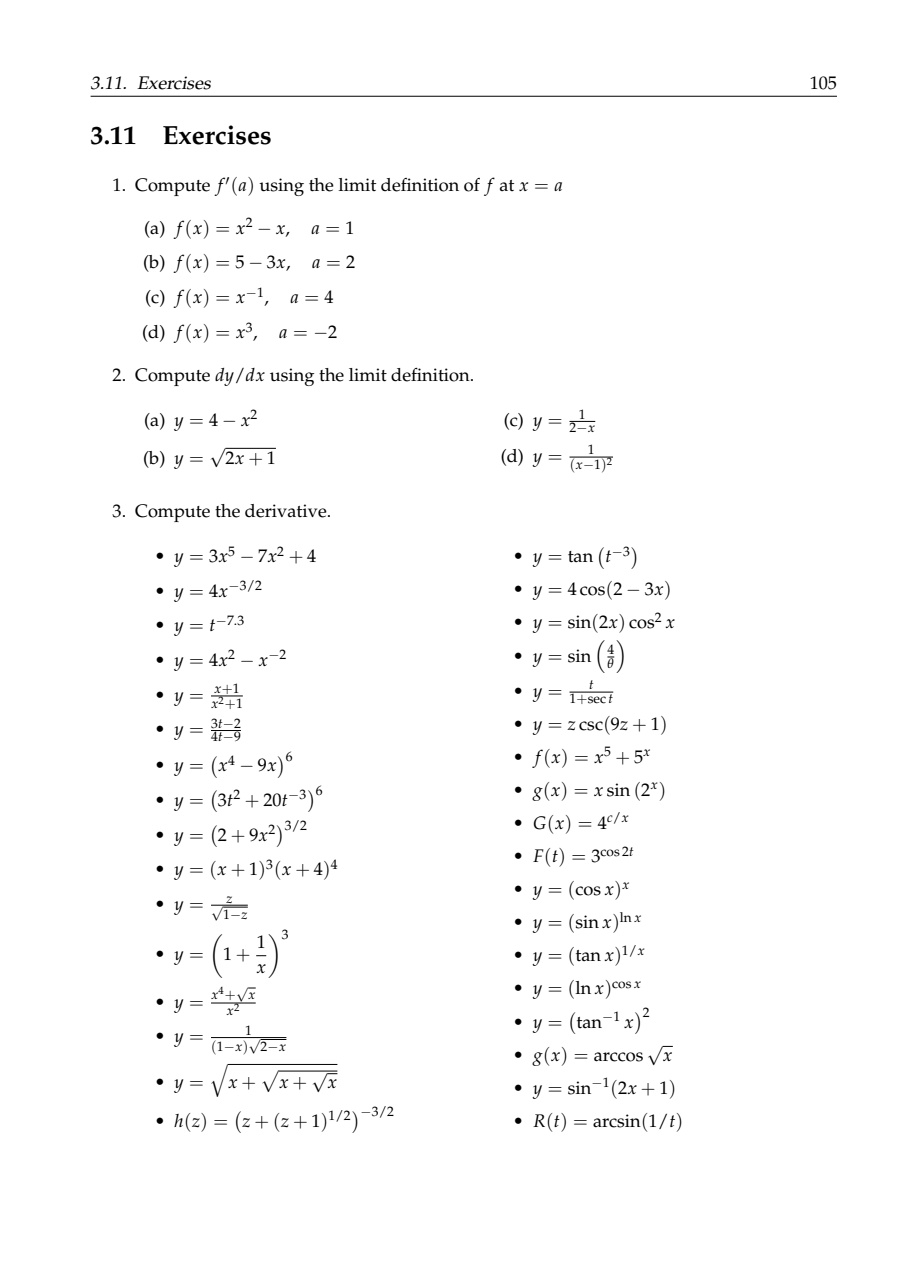1. Compute f'(a) using the limit definition of f at x = a. 2. Compute dy/dx using the limit definition. 3. Compute the derivative.

Understand the Problem
The question is asking to compute derivatives using the limit definition and to compute derivatives of various functions listed. It involves applying calculus principles, specifically the rules for differentiation and the limit definition of a derivative.
Answer
- (a) \( 1 \) - (b) \( -3 \) - (c) \( -\frac{1}{16} \) - (d) \( 12 \)
Answer for screen readers
- (a) ( f'(1) = 1 )
- (b) ( f'(2) = -3 )
- (c) ( f'(4) = -\frac{1}{16} )
- (d) ( f'(-2) = 12 )
Steps to Solve
- Deriving using the limit definition
For each function, the derivative can be computed using the limit definition:
$$ f'(a) = \lim_{h \to 0} \frac{f(a+h) - f(a)}{h} $$
- Function (a): ( f(x) = x^2 - x ) at ( a = 1 )
First, calculate ( f(1) ):
$$ f(1) = 1^2 - 1 = 0 $$
Now compute ( f(1+h) ):
$$ f(1+h) = (1+h)^2 - (1+h) = 1 + 2h + h^2 - 1 - h = h^2 + h $$
Now apply the limit:
$$ f'(1) = \lim_{h \to 0} \frac{(h^2 + h) - 0}{h} = \lim_{h \to 0} (h + 1) = 1 $$
- Function (b): ( f(x) = 5 - 3x ) at ( a = 2 )
Calculate ( f(2) ):
$$ f(2) = 5 - 3(2) = -1 $$
Now compute ( f(2+h) ):
$$ f(2+h) = 5 - 3(2+h) = 5 - 6 - 3h = -1 - 3h $$
Applying the limit:
$$ f'(2) = \lim_{h \to 0} \frac{(-1 - 3h) - (-1)}{h} = \lim_{h \to 0} \frac{-3h}{h} = -3 $$
- Function (c): ( f(x) = x^{-1} ) at ( a = 4 )
Calculate ( f(4) ):
$$ f(4) = \frac{1}{4} $$
Now compute ( f(4+h) ):
$$ f(4+h) = \frac{1}{4+h} $$
Applying the limit:
$$ f'(4) = \lim_{h \to 0} \frac{\frac{1}{4+h} - \frac{1}{4}}{h} $$
Finding a common denominator:
$$ = \lim_{h \to 0} \frac{4 - (4+h)}{4(4+h)h} = \lim_{h \to 0} \frac{-h}{4(4+h)h} = \lim_{h \to 0} \frac{-1}{4(4+h)} = -\frac{1}{16} $$
- Function (d): ( f(x) = x^3 ) at ( a = -2 )
Calculate ( f(-2) ):
$$ f(-2) = (-2)^3 = -8 $$
Now compute ( f(-2+h) ):
$$ f(-2+h) = (-2+h)^3 = -8 + 12h - 6h^2 + h^3 $$
Applying the limit:
$$ f'(-2) = \lim_{h \to 0} \frac{(-8 + 12h - 6h^2 + h^3) - (-8)}{h} = \lim_{h \to 0} \frac{12h - 6h^2 + h^3}{h} = \lim_{h \to 0} (12 - 6h + h^2) = 12 $$
- (a) ( f'(1) = 1 )
- (b) ( f'(2) = -3 )
- (c) ( f'(4) = -\frac{1}{16} )
- (d) ( f'(-2) = 12 )
More Information
The limit definition of the derivative illustrates how to determine the slope of the tangent line at any point on a curve. Each computed derivative provides critical information about the behavior of the function at given points.
Tips
- Forgetting to simplify after applying the limit definition can lead to incorrect results. Always ensure to simplify the expression before evaluating the limit.
- Confusing the function evaluated at ( a ) with how the function behaves as ( h ) tends to 0. Make sure to differentiate clearly between ( f(a) ) and ( f(a + h) ).
AI-generated content may contain errors. Please verify critical information